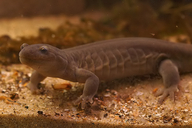|
Description
Hynobius dunni has a SVL of 60-80 mm and a total length of 100-160 mm. Generally there are 12 costal grooves, though occasionally salamanders of this species have 11 costal grooves. It is similar to H. nebulosus, but stouter, with a larger head, and a less rounded snout. Its limbs are moderately developed. The tail is short, thick at the base, and laterally compressed toward the tip. Vomerine and palatine teeth series are in the form of a “U.” The dorsal surfaces are brown with small greenish flecks, while the ventral surfaces are bluish gray and become lighter on the throat. During the reproductive period, the head, hindlimbs, and caudal fin of the male become enlarged. At this time coloration also becomes more subdued. Distribution and Habitat
Country distribution from AmphibiaWeb's database: Japan
H. dunni is found in ponds, rice paddies and their margins, and in zones around the edges of forests and in bamboo forests. Its distribution is restricted to Oita, Kumamoto, and Miyazaki in the northeastern part of Kyushu and Kochi in Skikoku.Life History, Abundance, Activity, and Special Behaviors
Hynobius dunni belongs to the family Hynobiidae, which is one of only two salamander families exhibiting external fertilization of eggs. Females lay 18-100 eggs per sac in slow moving water. This species is one of several where the males take part in a "scramble competition" for females (Hasumi 1994). One male will detect a female in the act of extruding egg sacs and attaching them to a substrate. He then folds himself around the egg sacs, causing the female to extrude them fully and pushing the female away. Other males (scramblers) will then join the first male to form a mating ball around the pair of egg sacs, competing to fertilize the eggs. During the breeding phase, males also undergo a noticeable increase in head width
(Hasumi and Iwasawa 1990; Hasumi 1994). Trends and Threats
H. dunni is threatened by commerce and by the destruction of its habitat. Relation to Humans
H. dunni is bred in captivity. Possible reasons for amphibian decline General habitat alteration and loss
Urbanization
Disturbance or death from vehicular traffic
Subtle changes to necessary specialized habitat
Local pesticides, fertilizers, and pollutants
Intentional mortality (over-harvesting, pet trade or collecting)
References
Hasumi, M. (1994). ''Reproductive behavior of the salamander Hynobius nigrescens: monopoly of egg sacs during scramble competition.'' Journal of Herpetology, 28(2), 264-267.
Hasumi, M. and Iwasawa, H. (1990). ''Seasonal changes in body shape and mass in the salamander, Hynobius nigrescens J.'' Journal of Herpetology, 24(2), 113-118.
Raffaëlli, J. (2007). Les Urodèles du monde. Penclen Edition, France.
Originally submitted by: Nichole Winters (first posted 2007-02-15)
Edited by: Kellie Whittaker (2008-09-09)Species Account Citation: AmphibiaWeb 2008 Hynobius dunni: Oita Salamander <https://amphibiaweb.org/species/3882> University of California, Berkeley, CA, USA. Accessed Mar 28, 2025.
Feedback or comments about this page.
Citation: AmphibiaWeb. 2025. <https://amphibiaweb.org> University of California, Berkeley, CA, USA. Accessed 28 Mar 2025.
AmphibiaWeb's policy on data use.
|





 Raffaëlli Account
Raffaëlli Account Map of Life
Map of Life